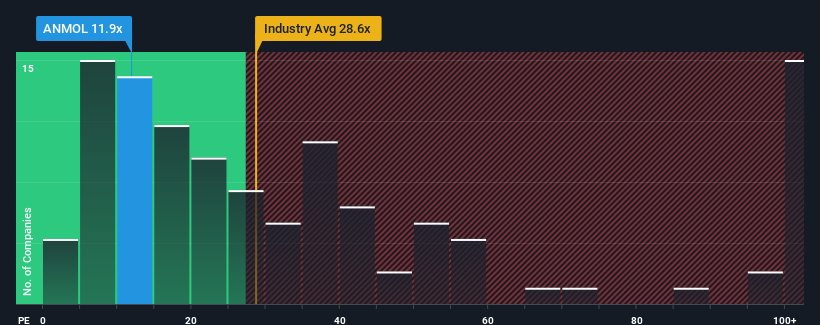- India
- /
- Trade Distributors
- /
- NSEI:ANMOL
Market Cool On Anmol India Limited's (NSE:ANMOL) Earnings Pushing Shares 25% Lower

The Anmol India Limited (NSE:ANMOL) share price has fared very poorly over the last month, falling by a substantial 25%. Looking back over the past twelve months the stock has been a solid performer regardless, with a gain of 19%.
Since its price has dipped substantially, Anmol India may be sending very bullish signals at the moment with its price-to-earnings (or "P/E") ratio of 11.9x, since almost half of all companies in India have P/E ratios greater than 29x and even P/E's higher than 54x are not unusual. However, the P/E might be quite low for a reason and it requires further investigation to determine if it's justified.
Earnings have risen firmly for Anmol India recently, which is pleasing to see. One possibility is that the P/E is low because investors think this respectable earnings growth might actually underperform the broader market in the near future. If that doesn't eventuate, then existing shareholders have reason to be optimistic about the future direction of the share price.
See our latest analysis for Anmol India

Does Growth Match The Low P/E?
Anmol India's P/E ratio would be typical for a company that's expected to deliver very poor growth or even falling earnings, and importantly, perform much worse than the market.
Retrospectively, the last year delivered an exceptional 23% gain to the company's bottom line. Pleasingly, EPS has also lifted 94% in aggregate from three years ago, thanks to the last 12 months of growth. Therefore, it's fair to say the earnings growth recently has been superb for the company.
It's interesting to note that the rest of the market is similarly expected to grow by 24% over the next year, which is fairly even with the company's recent medium-term annualised growth rates.
With this information, we find it odd that Anmol India is trading at a P/E lower than the market. Apparently some shareholders are more bearish than recent times would indicate and have been accepting lower selling prices.
The Final Word
Anmol India's P/E looks about as weak as its stock price lately. We'd say the price-to-earnings ratio's power isn't primarily as a valuation instrument but rather to gauge current investor sentiment and future expectations.
We've established that Anmol India currently trades on a lower than expected P/E since its recent three-year growth is in line with the wider market forecast. When we see average earnings with market-like growth, we assume potential risks are what might be placing pressure on the P/E ratio. It appears some are indeed anticipating earnings instability, because the persistence of these recent medium-term conditions should normally provide more support to the share price.
There are also other vital risk factors to consider before investing and we've discovered 1 warning sign for Anmol India that you should be aware of.
You might be able to find a better investment than Anmol India. If you want a selection of possible candidates, check out this free list of interesting companies that trade on a low P/E (but have proven they can grow earnings).
New: Manage All Your Stock Portfolios in One Place
We've created the ultimate portfolio companion for stock investors, and it's free.
• Connect an unlimited number of Portfolios and see your total in one currency
• Be alerted to new Warning Signs or Risks via email or mobile
• Track the Fair Value of your stocks
Have feedback on this article? Concerned about the content? Get in touch with us directly. Alternatively, email editorial-team (at) simplywallst.com.
This article by Simply Wall St is general in nature. We provide commentary based on historical data and analyst forecasts only using an unbiased methodology and our articles are not intended to be financial advice. It does not constitute a recommendation to buy or sell any stock, and does not take account of your objectives, or your financial situation. We aim to bring you long-term focused analysis driven by fundamental data. Note that our analysis may not factor in the latest price-sensitive company announcements or qualitative material. Simply Wall St has no position in any stocks mentioned.
About NSEI:ANMOL
Adequate balance sheet and slightly overvalued.

